The week at a glance
- Short-toed Treecreeper in Suffolk
- Possible Little Swift in West Sussex
- Pied-billed Grebe still in Argyll
- Oriental Turtle Dove still in Oxfordshire
- White-winged Scoter still in Co Kerry
- House Crow still in Co Cork
With spring migration continuing apace there were plenty of new arrivals to keep birders out in the field, with the run of quality birds continuing. The best bird of the week was rather typically found in a mist net at Landguard Bird Observatory (Suffolk) on the morning of 24th. This was the county's first Short-toed Treecreeper, which continued to give occasional good views all week in the Observatory compound and along Icky Ridge — webzine subscribers can read the finder's account at https://www.birdguides.com/articles/rarity-finders-short-toed-treecreeper-suffolk/. Of the previous 23 records, no fewer than 12 have come from Dungeness Bird Observatory (Kent), with the county accounting for 18 in total. Others have come from Essex and Dorset, with just one bird further north, ringed at Hornsea Mere (East Yorkshire) in 1970. Rather incredibly this is the 17th bird to be ringed, which certainly prompts the question of how many 'field records' go unnoticed.
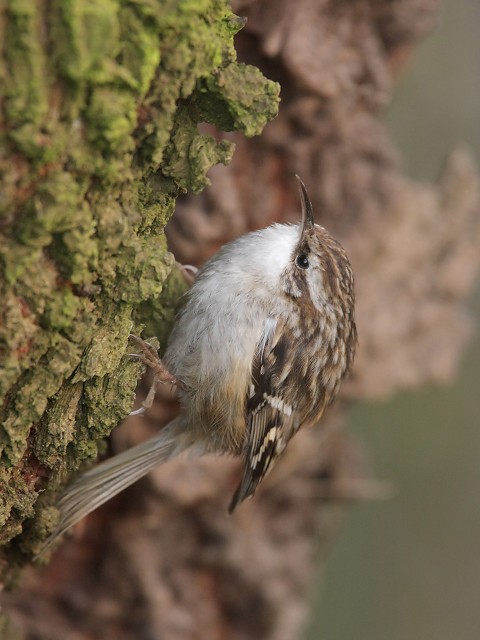
Short-toed Treecreeper, Landguard NR, Suffolk (Photo: Chris Mayne)
The only other new mega was unfortunately brief and unconfirmed: a possible Little Swift over Sidlesham Ferry (West Sussex) on 24th. These are classic one-day birds, so an accessible bird would be very much in demand, but the date is rather early; there are no previous March records. There was also a further 'swift sp.' reported, over Newport Wetlands (Gwent) on 26th.
Elsewhere, most of the month's quality birds lingered, not least the Pied-billed Grebe which was at Salen, Mull (Argyll) to at least 29th, showing slightly better now. After a week-long absence, the Chipping Norton (Oxfordshire) Oriental Turtle Dove was back in the garden at No. 41 from 29th, with viewing reinstated by the ever-tolerant and obliging owners. In Ireland, the drake White-winged Scoter remained off Rossbeigh (Co Kerry) all week and the resident House Crow also remained in Cobh (Co Cork).
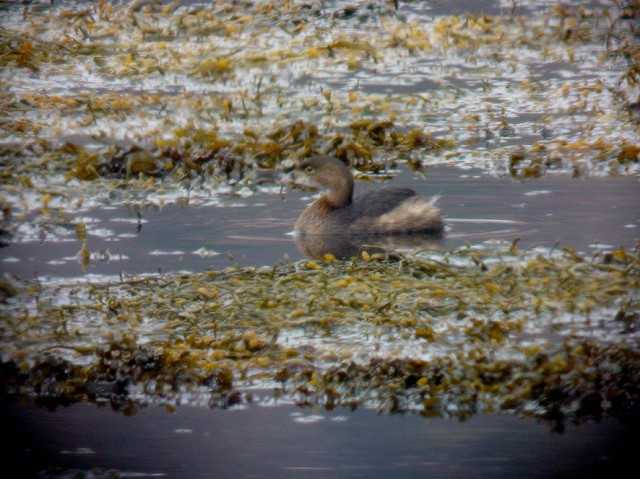
Pied-billed Grebe, Salen, Mull, Argyll (Photo: Jim Dickson)
The Snow Goose remained on Shetland this week, reported from Laxfirth on 26th and Loch of Vatster on 28th, and one at Aghalee and Aghagallon (Co Antrim) on 26th–28th may have been the Portmore bird relocating. There were no reports of the Norfolk Ross's Goose, but several records came from the northwest and southern Scotland. One was at Loch Leven (Perth & Kinross) on 27th–28th with another at Dowlaw (Borders) on 27th–28th and the wintering birds were reported again from Doddington (Northumberland) on 29th and Rockcliffe Marsh (Cumbria) on 26th.

Snow Goose, Aghagallon, Antrim (Photo: Tristan Reid)
There were still just two Black Brants this week, though they were different to last week's, with one at Hunstanton (Norfolk) on 26th and one at Dungarvan and The Cunnigar (Co Waterford) on 28th–29th. The rather genuine-looking Red-breasted Goose remained at Vane Farm (Perth & Kinross) on 27-28th — Loch Leven has now held five of the six county records. The Lesser Canada Goose remained at Malin Head (Co Donegal) to at least 26th and the Taverner's Canada Goose was reported from Ballyconnell (Co Sligo) on 27th.

Black Brant, Dungarvan, Waterford (Photo: Hepatitis@eircom.Net)

Red-breasted Goose, Loch Leven, Perth & Kinross (Photo: Willie McBay)
In an East Anglia switch-around, the Suffolk Ferruginous Duck left to be replaced by the female again at Cockshoot Broad (Norfolk) on 26th. Perhaps present all along, there was also a drake reported from Chew Valley Lake (Somerset) on 28th, along with three Scaup. There was another new drake Ring-necked Duck, this time at Seaforth LWT (Lancashire) on 24th–25th. Another remained in Co Fermanagh, at Boa Island on 29th, the female was at Bosherston Lily Ponds (Pembrokeshire) on 24th, the drake was still at Lough Cowey (Co Down), and in Cornwall the wandering drake was at Gwithian on 27th–28th and then back at Stithians Reservoir on 30th. The female at Llyn Pencarreg (Carmarthen) on 26th was presumably the bird that was last seen there on 21st December, and may also relate to the bird at nearby Talley Lakes from 18th January to 15th February.

Ring-necked Duck, Seaforth LWT (Permit only), Lancashire (Photo: Pete Kinsella)
Green-winged Teal were very evenly spread during the week, with three in England (the debatable bird at Connaught Water (Essex) and others at Cresswell Pond (Northumberland) and Newburgh Priory (North Yorkshire)), two in Wales (at Marloes Mere (Pembrokeshire) and a new bird at Peterstone Wentlooge (Gwent) from 25th), two in Scotland (at Kildrochat (Dumfries & Galloway) and a new bird at Loch of Strathbeg (Aberdeenshire) on 27th) and one in Ireland (still at Tacumshin (Co Wexford)). Also from the west, the drake Blue-winged Teal remained at Sandy Water Park (Carmarthen) all week and the American Wigeon also remained at Rushy Common (Oxfordshire) to at least 27th. There was then another drake, at Cresswell Pond (Northumberland) on 27th–30th.
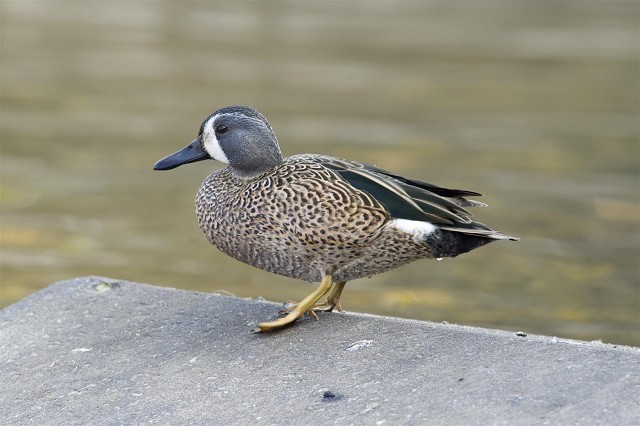
Blue-winged Teal, Sandy Water Park, Carmarthen (Photo: Julian Evans)
Long-staying Lesser Scaup included the female at Slimbridge (Gloucestershire) and the drakes at Cosmeston Lakes (Glamorgan) and Milton Loch (Dumfries & Galloway), and the new drake at Marshside RSPB (Lancashire) also remained to at least 29th.
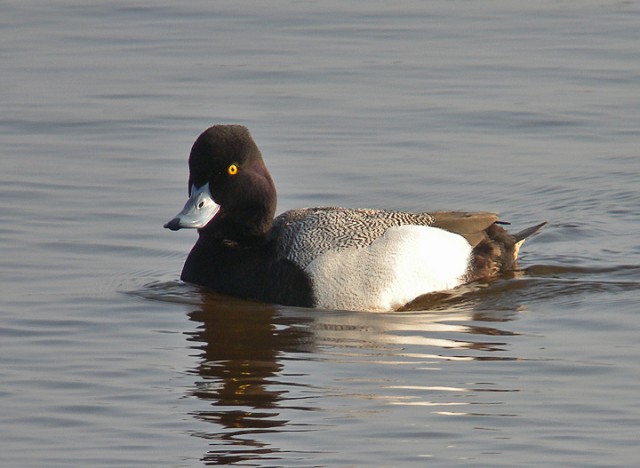
Lesser Scaup, Marshside RSPB, Lancashire (Photo: anon)
As usual, the regular Surf Scoters were reported off Dawlish Warren (Devon) and back off Ruddon's Point (Fife), with probably the same off Lower Largo on 28th. There was then another report of a female off Rossbeigh (Co Kerry) on 29th. The two drake King Eiders, an adult and a first-winter, remained in Uyeasound, Unst (Shetland) to 24th, and another returning bird was on the Ythan estuary (Aberdeenshire) on 30th. Scotland also produced several Northern Eiders, with one at Tarbat Ness (Highland) on 26th–27th and three at Golspie (Highland) on 27th–29th, and one also at nearby Embo on 28th. This stretch of coast also produced up to 15 Slavonian Grebes and 160 Long-tailed Ducks. Last but not least was a drake living it up in Stinky Bay, Benbecula (Outer Hebrides) on 30th. Also on the sea were White-billed Divers at Cromane (Co Kerry) on 26th–27th — only the second for the county following one in 1996 — and the more likely location of North Ronaldsay (Orkney) on 28th.
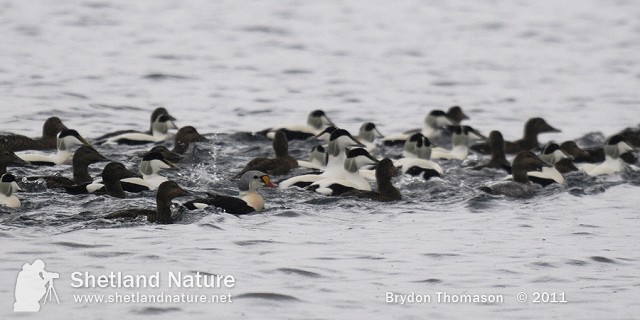
King Eider, Uyeasound, Unst, Shetland (Photo: Brydon Thomason)

White-billed Diver, Cromane, Kerry (Photo: Richard Jeffree)
Smew remained at just four sites in England this week — including five at Paxton Pits (Cambridgeshire) — one site in Northern Ireland — Quoile Pondage (Co Down) on 27th — and three sites in Scotland — a drake remained at Lochwinnoch (Strathclyde), a redhead was at Lindores Loch (Fife) on 26th–27th, as were 45 Sand Martins, and another redhead remained at Loch of Clickimin (Shetland) to 24th. There was a minute flicker of interest in the Hooded Merganser at Sidlesham Ferry (West Sussex) on 26th, though this is presumably the bird that has been at Radipole Lake (Dorset) since June 2008, last reported on 19th February.

Hooded Merganser, Sidlesham Ferry, West Sussex (Photo: Mickd)
As might be expected, there were just a couple of records of Balearic Shearwater: past Flamborough Head (East Yorkshire) on 25th and off Dawlish Warren (Devon) on 27th.
Perhaps pre-empting a return to our shores this next week, there was a Purple Heron at Rue des Bergers Nature Reserve (Guernsey) on 26th. Great White Egrets still seemed rather scarce though this week. Apart from one at Meare Heath (Somerset), others were all new birds. One at West Hartford (Northumberland) on the evening of 24th soon turned into two, though they stayed for less than 30 minutes. Other brief birds were at Inishannon (Co Cork) on 24th, Slapton Ley (Devon) on 25th and Titchfield Haven (Hampshire) on 26th, and there was a report of three over Copdock (Suffolk) on 28th. Perhaps surprisingly, the only Cattle Egret was one following a plough at Carlton Marshes (Suffolk) on the afternoon of 28th.
Small numbers of Spoonbills remained at 12 widespread sites along the south coast and in southern Ireland, with three at Walmsley Sanctuary (Cornwall) the highest count. Further north, the only record was of one over Saltholme (Cleveland) on 29th. A run of records of White Stork in Lancashire probably all related to the same colour-ringed escapee. It was at Pilling Lane Ends and Stake Pool on 26th, then at Ormskirk and Halton on 27th. There was also a report of a possible over Tebay (Cumbria) on 27th, being mobbed by Black-headed Gulls. Sadly my Glossy Ibis prediction didn't come true, as there were no further reports this week.

White Stork, Pilling Lane Ends, Lancashire (Photo: Jonny Scragg (aged 16))
There were two distinct clusters of Rough-legged Buzzards reported, with birds along the coast from northwest Norfolk to south Suffolk and spread across north Derbyshire, north Lincolnshire and East Yorkshire. Away from here, one was still at Toft (Shetland) all week and another was reported from Ocknell Plain (Hampshire) on 27th. The Hampshire White-tailed Eagle was last seen on 24th heading south over Basingstoke, with a later report being the result of an inadvertent omission of the word 'not' on a report. In west Cornwall, the presumed escape Golden Eagle continued to wander, seen at four widespread locations to 29th.
Three of the remaining juvenile Northern Harriers were reported this week, at Loch Barvas, Lewis (Outer Hebrides) on 25th, Tacumshin (Co Wexford) on 26th and Blackditch (Co Wicklow) on 27th. The possible Tundra Peregrine remained at Walmsley Sanctuary (Cornwall) all week and a Gyr Falcon was on North Uist (Outer Hebrides) on 25th–26th. There was also an unconfirmed report of a Black Kite over Hardingstone Gravel Pits (Northamptonshire) on 29th. Good numbers of Ospreys are back on territory now, with many of them having their own webcams, but if you want to see one for yourself then do check out our recent webzine article.
None of last week's Spotted Crakes stayed for more than a day, but one at Brandon Marsh (Warwickshire) was more obliging, staying from 27th to the end of the week.

Spotted Crake, Brandon Marsh NR, Warwickshire (Photo: Max Silverman.)
The itchy-footed Long-billed Dowitcher did exactly the same as last week, spending all week at Lodmoor (Dorset) apart from a day at Radipole Lake on 25th. Little Ringed Plovers arrived in numbers this week, as far north as Cresswell Ponds (Northumberland). The peak counts reported were seven at Dartford (Kent) on 24th and six on floods at Newington (Nottinghamshire) on 26th.
There were still reasonable numbers of Glaucous Gulls around, especially in Scotland, although many have now left their Midlands haunts. The same could be said of Iceland Gulls, although there were still more of these diminutive white-wingers. All were singletons and most remaining birds now seem to be juveniles. The Kumlien's Gull remained in Sligo all week and Ireland also hogged most of the Ring-billed Gulls, with the only reports east of the Irish Sea being the long-staying birds at Poole (Dorset) and Dingwall (Highland). Irish birds were at five sites in Counties Clare, Kerry and Cork, and included five still at Cuskinny Marsh (Co Cork) on 25th.

Glaucous Gull, Campbeltown Loch, Argyll (Photo: Jimmy MacDonald)

Kumlien's Gull, Sligo, Sligo (Photo: Tristan Reid)
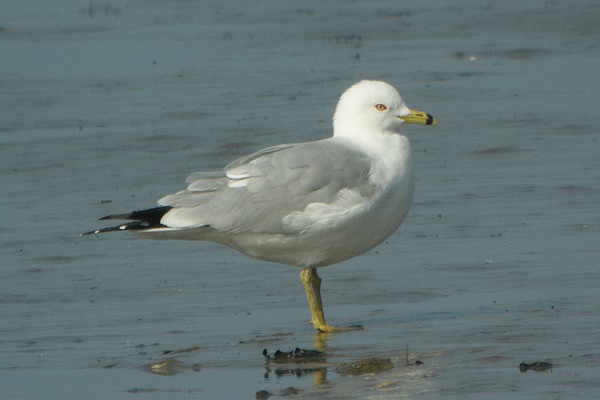
Ring-billed Gull, Blennerville, Kerry (Photo: Tristan Reid)
The near-adult Baltic Gull in Suffolk remained a possible, present at Lackford Lakes to 27th and then at Livermere Lake on 28th–29th. There was also a possible adult photographed at the London Wetland Centre on 27th and although present for just 10 minutes it looked to have equally good credentials. It then turned into fuscus-fever, with another report on 30th, this time of a possible first-summer at Pegwell Bay (Kent), although this will prove extremely difficult to get accepted. In Wales, the two adult Bonaparte's Gulls stayed put at Lligwy Bay (Anglesey) and Cardiff Bay (Glamorgan).

Baltic Gull, Lackford Lakes SWT, Suffolk (Photo: David H Hatton)
It was pretty much 'as you were' for Shore Larks again, with birds at the usual sites, including peak counts of 10 at Cley Marshes (Norfolk) and Dingle Marshes (Suffolk) and the singleton remaining at Warton, near Carnforth (Lancashire) on 23rd. After going missing for a couple of months, five birds returned to John Muir Country Park (Lothian) on 25th–29th.

Shore Lark, John Muir CP, Lothian (Photo: Bruce Kerr)
The southwest was, unsurprisingly, the place to be for Hoopoes, with all bar three in Devon and Cornwall. The exceptions were another bird at Portland (Dorset) on 28th–29th and two in Co Cork, near Goleen on 26th and on Sherkin Island on 30th. Cornish birds roamed around the Land's End area, with others at Morvah, Ashington and on the cricket pitch in Penzance. In Devon, birds were on Lundy and at Axmouth, Wembury and Slapton. The Channel Islands also saw birds at two sites on Guernsey: at Prevote on 24th and Les Adams on 26th.

Hoopoe, Penzance, Cornwall (Photo: Ashley Hugo)
With both of the common early hirundines now well spread, we'll leave it to BirdTrack to report on their core arrival. At the moment, the reporting rate for Sand Martin shows a good early arrival, with the rate for Swallow lagging behind slightly. Whether this is a true reflection of a late arrival will become clear over the coming weeks, so do keep checking back. We're also due the first real numbers of House Martins over the next week or so.
After last week's small arrival of Bluethroats, there was just one this week, another white-spotted bird, ringed at Porth Hellick, St Mary's (Isles of Scilly) on 25th. The continued good weather at the start of the week brought plenty of other migrants into the country, with a few Yellow Wagtails from 28th, good numbers of Redstarts as far as North Yorkshire and the first Pied Flycatcher, at Yarner Wood (Devon) on 28th. There were also small numbers of Sedge Warblers and the first Grasshopper Warbler, at Llanrhystud (Ceredigion) on 29th, and Reed Warbler, at Lodmoor (Dorset) on 30th. Far more numerous were Phylloscopus warblers, with a small fall on Bardsey Island (Gwynedd) on 29th including 360 Willow Warblers, 236 Chiffchaffs and 57 Blackcaps.
Plenty of Waxwings remained at many sites across central and southern England. There were reports from just seven sites in Scotland, peaking at 38 in Perth on 29th, and 17 were still in Belfast on 18th. In England, peak counts came from the usual places, though no flocks are now larger than 75–80 birds.
The two Suffolk Penduline Tits were at Dingle Marshes on 24th, before moving back to Minsmere on 25th. One of these birds is ringed, and although the number can't be read, it does look as though this is a Dutch-ringed bird, which would be only the second to be found in the UK. Other foreign-ringed Penduline Tits found in the UK have come from Spain (two) and Sweden.
As spring progresses, Great Grey Shrikes seem to be spreading out, although there are still local concentrations in Hampshire and Dorset. Birds were then thinly spread across England and Wales, with just one in Scotland, again at Rhynie (Aberdeenshire) on 25th. There was also one in Ireland, briefly at Slievenacloy (Co Antrim) on 30th. The first-winter Rose-coloured Starling remained in Penzance (Cornwall) to at least 29th.
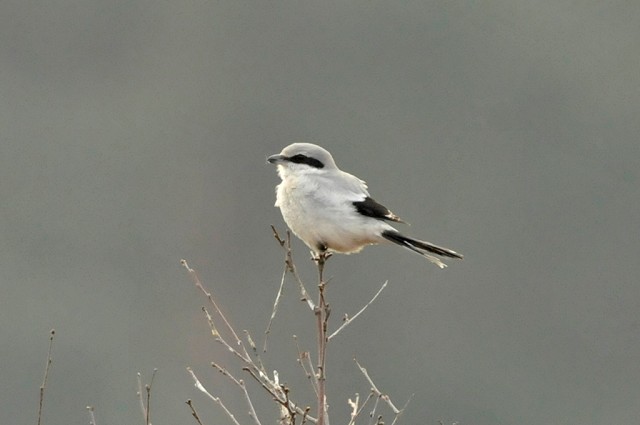
Great Grey Shrike, Upper Hollesley Common, Suffolk (Photo: Stephen Allen)

Great Grey Shrike, High Vinnalls, Herefordshire (Photo: George Ewart)
Seemingly for the first time this winter, the week saw no reports of Arctic Redpolls of any description, and all reported counts of Mealy Redpolls were in single figures. There were also much reduced numbers of Bramblings present, although the BirdTrack reporting rate still suggests that they are quite widespread, present on 4% of complete lists submitted. At the other end of the spectrum, sure signs of spring came in the form of a male and female Serin at Dungeness (Kent) on 27th–29th.
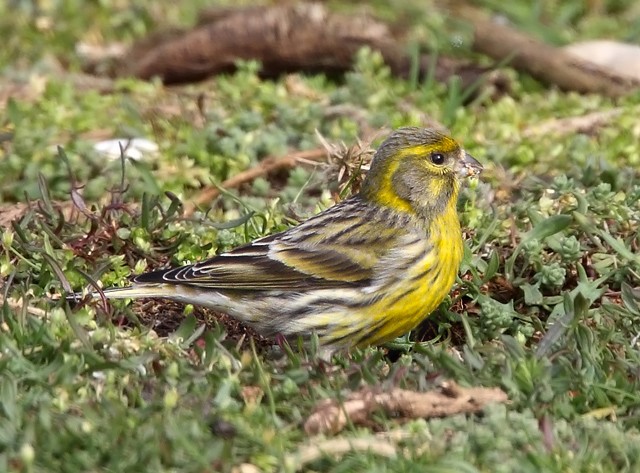
Serin, Dungeness BO, Kent (Photo: Steve Ashton)
There was a definite move northwards in the remaining Lapland Buntings, with birds at numerous sites in the northeast, peaking at 29 at Flamborough Head (East Yorkshire) on 27th, and into western Scotland. In the south, one remained at Abberton Reservoir (Essex) to 25th and one was at Sker Point (Glamorgan) on 23rd–24th.
The only report of Northern Long-tailed Tit was of a singleton at Hamsterley Forest (Durham) on 24th, though it wasn't seen subsequently. Also in Durham was a Nordic Jackdaw, at Whitburn on 29th, with the only other at Landguard (Suffolk) on 29th–30th. The Central Asian Lesser Whitethroat also remained in Drogheda (Co Louth) all week.
Photo of the Week: 24th–30th March 2011

Little Owl, undisclosed site, Leicestershire and Rutland (Photo: Paul Riddle)
It's not unusual for birders to set themselves targets related to the number of birds they want to see and/or photograph, but it's not often those targets relate to a single species. Since August 2008, Leicestershire-based Paul Riddle has been trying to locate as many Little Owl territories as possible within his local area and is now up to a staggering tally of 163 territories! In addition to recording sites and getting involved in related conservation work, Paul has been taking photos of the owls at the majority of the sites and has shared many of his excellent images on BirdGuides as well as on his own blog. As you'd expect, Paul's focus on a single species has resulted in a great variety of Little Owl images, several of which have featured in our weekly Notables. This week, though, it's our pleasure to be able to award Paul his first Photo of the Week for his stunning portrait of a calling bird in a sumptuously natural setting. Dappled sunlight picks out the owl and its dead tree perch, outlining them against the darker and more diffuse tree trunk backdrop. The outlines of the owl and perch form perfect shapes within the vertical frame, leading up to the centrally placed head facing directly at the viewer. It's easy to imagine an artist choosing exactly this composition as the basis for a painting. As icing on the cake, Paul perfectly timed the shot to capture the brilliant yellow eyes and wide open bill. We now look forward to seeing Paul achieve his aim of bagging the perfect Little Owl flight shot.
Other notable photos

Black-necked Grebe, undisclosed site, Cheshire (Photo: Ivan Ellison)
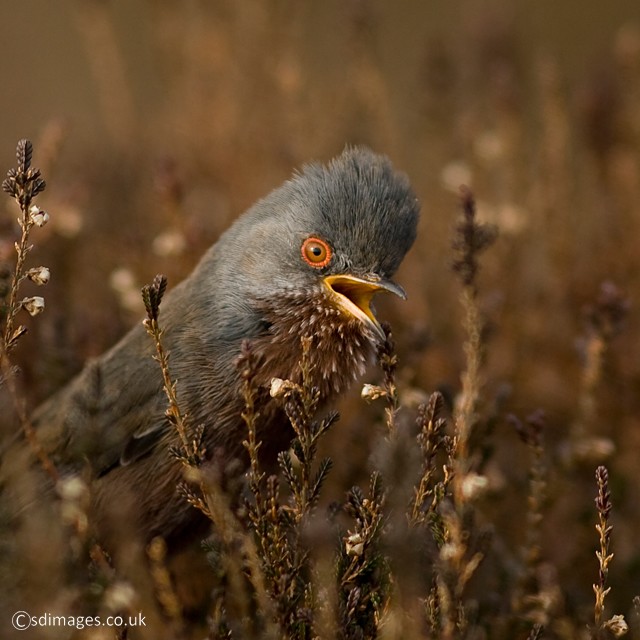
Dartford Warbler, World's End, Clwyd (Photo: Steve Dolan)

Great White Egret, Meare Heath, Somerset & Bristol (Photo: Jeff Hazell)

Common Crane, India (Photo: Tejas Soni)

Reed Bunting, Waltham Abbey, Essex (Photo: Rob Anderson)

Wren, Spital, Cheshire (Photo: Steve Round)

Long-eared Owl, undisclosed site, Suffolk (Photo: Chris Darby)

Desert Wheatear, Morocco (Photo: Daniel Trim)

Garganey, Gosforth Park NR, Northumberland (Photo: Terry Cavner)

Shoveler, Belfast Lough RSPB, Antrim (Photo: Ian Dickey)

Dipper, Cramond, Lothian (Photo: Phil Johnston)

House Sparrow, Norwich, Norfolk (Photo: R J Saxton)

Sparrowhawk, Hethersett, Norfolk (Photo: Chris Archer)

Common Redshank, Salthouse, Norfolk (Photo: Garth Peacock)
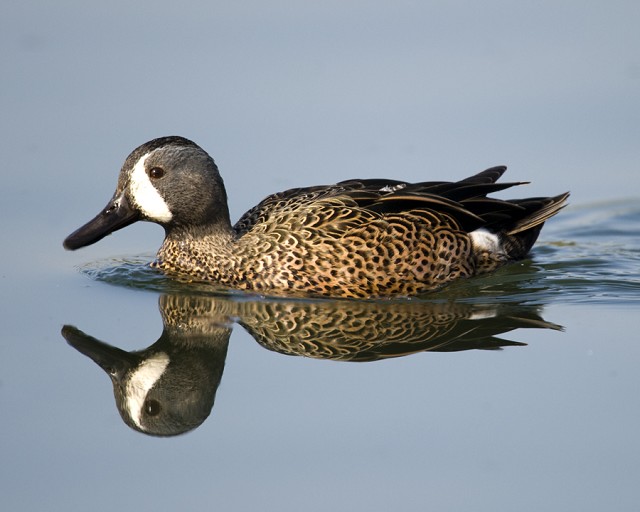
Blue-winged Teal, Sandy Water Park, Carmarthen (Photo: Mic Clark)

European Bee-eater, Gambia (Photo: Ashley Grove)

Common Crossbill, Kerry Ridgeway, Shropshire (Photo: Paul_Leafe)

Common Treecreeper, Stodmarsh NNR, Kent (Photo: Steve Ashton)

Nuthatch, undisclosed site, Shropshire (Photo: John Fielding)

Hoopoe, Les Adams, Guernsey (Photo: Chris Bale)

